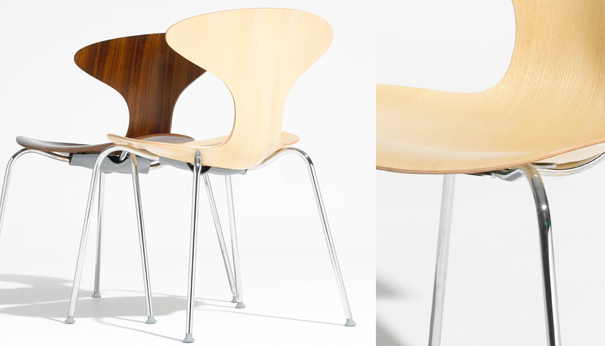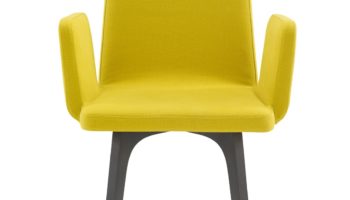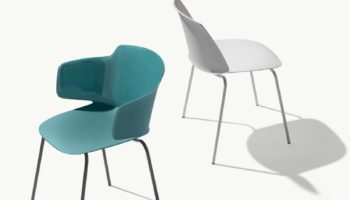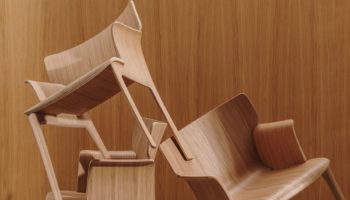#NeoCon09: Lovegrove and Bernhardt Design Orbit to New Heights
Having recently returned from a five-day family visit to greater Los Angeles and environs, I find myself re-living the trip’s highlights, one of which was the chance to re-familiarize myself with the seminal Eames Lounge Chair Wood (LCW), which happily graces a sunny corner of the guestroom in my brother’s PicFair home.
Orbit. Designed by Ross Lovegrove for Bernhardt Design.
This particular Eames is the origin of many “firsts” in modern design: first non-upholstered piece made of bentwood ply, first ergonomic lounge chair, first winner of the Museum of Modern Arts’ “Organic Furniture Competition” in 1940. If you’ve never sat in an LCW, you owe it to yourself to trot out to your local Vitra distributor and sample its flawless contours. My favorite feature is its “forced” ergonomic profile—the way the smooth veneer and the subtle angle of the seat pan nudges you into an anatomically advantageous position, which, in concert with the versatile aesthetic, establishes its permanence as a classic of modern design.

All this is a longish segue to Ross Lovegrove‘s Orbit for (featured #NeoCon09 exhibitor) Bernhardt Design, a stackable, multi-purpose chair with sculpted plywood shell and chrome base that’s conceptually indebted to the LCW. Lovegrove isn’t the only one whose work shows this distinct influence: the short list of derivative pieces we’ve covered in the last year includes Anthony Marschak’s Spring Chair, Daniel Milchtein Peltsverger’s 2+ Stackable Chairs, and Will Oltman’s Tolima Chair. Lovegrove’s piece—in vintage synergistic Lovegrove style—is derivative by half, the plywood shell evoking the best of LCW and the chrome legs evoking the best of, well, Lovegrove.
Bernhardt elaborates on this distinction: “at first glance, Orbit appears to be a familiar Scandinavian plywood chair. Upon closer inspection, the chair reveals a graceful, modern form. The profile is much thinner and sleeker, the chair more shapely than any of its many predecessors.” As noted, the refined profile is one point of departure from the LCW and the synergistic materials are another. Additional differences (some might say “improvements,” but I’d hate to ruffle any purists’ feathers) include the single sheet construction; the tapered central axis doubling as a “rigid structural spine”; the “elevated structural mount” that “floats” the seat above the base, thus accounting for the shell’s ethereal aspect; and—perhaps the coup de grace—the tremendous variety of finishes (ash or zebrawood veneer in lacquer or natural, black lacquer on ash, or with polyethylene shell in a variety of glossy colors).
And let’s not forget stackability: Orbit comes with a quartet of rubber leg bumpers that keep stacked chairs from touching seats, thus protecting against scuffs and scratches. They can easily be stacked six high—a rare and enviable quality in a top-tier chair. The final assessment? LCW may live forever but Orbit has certainly taken a piece of the sculpted plywood pie. I’ll let Bernhardt have the last word: “ORBIT represents a major leap forward in the evolution of the iconic plywood stacking chair.” That it does…
See ORBIT alongside new work by Bernhardt Designs at Chicago’s #NeoCon09, June 15-17.




Leave a Reply